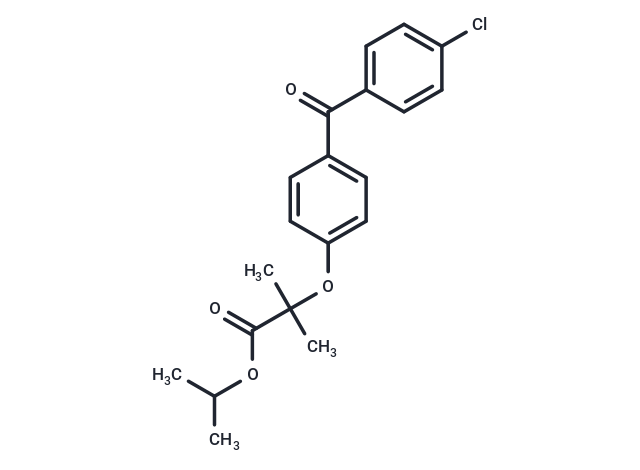Shopping Cart
- Remove All
 Your shopping cart is currently empty
Your shopping cart is currently empty

Fenofibrate (Lipanthyl) is a PPARα agonist (EC50=30 μM) and is selective. Fenofibrate also inhibits cytochrome P450 isoforms, such as CYP2C19, CYP2B6, CYP2C9, CYP2C8, and CYP3A4. Fenofibrate exhibits antihyperlipidemic activity.

| Pack Size | Price | Availability | Quantity |
|---|---|---|---|
| 100 mg | $32 | In Stock | |
| 200 mg | $45 | In Stock |
| Description | Fenofibrate (Lipanthyl) is a PPARα agonist (EC50=30 μM) and is selective. Fenofibrate also inhibits cytochrome P450 isoforms, such as CYP2C19, CYP2B6, CYP2C9, CYP2C8, and CYP3A4. Fenofibrate exhibits antihyperlipidemic activity. |
| Targets&IC50 | PPARα:30 μM(EC50) |
| In vitro | METHODS: MOLM13 cells were treated with LCL161 (1000-160000 nM) and PKC412 (2.5-40 nM) for 3 days, and cell viability was measured by trypan blue exclusion. RESULTS: LCL161 moderately inhibited cell growth when administered alone. the combination of LCL161 and PKC412 killed significantly more MOLM13-luc+ cells than either drug alone, and the Calcusyn Combination Index suggests a synergistic effect. [1] METHODS: NSCLC cells A549 and H460 were treated with LCL161 (10 µM) and paclitaxel (10 µM) for 48 h and apoptosis was detected by flow cytometry. RESULTS: Apoptosis was significantly reduced in the LCL161/paclitaxel combination treatment group compared to cells treated with LCL161 or paclitaxel alone. [2] |
| In vivo | METHODS: To test the antitumor activity in vivo, LCL161 (50 mg/kg twice daily) and PKC412 (40 mg/kg once daily) were administered by gavage to NCr nude mice injected with Ba/F3-FLT3-ITD-luc+ tumor cells for seven days. RESULTS: LCL161 significantly enhanced the ability of PKC412 to inhibit the growth of Ba/F3-FLT3-ITD-luc+ cells in vivo. the difference between the inhibition of leukemia growth by PKC412 or LCL161 alone and the combined inhibition of leukemia growth by PKC412+LCL161 was also significant. The weight of spleens of mice treated with PKC412+LCL161 percentage was less than that of mice treated with vector alone or either drug. [1] |
| Kinase Assay | The half-maximal inhibitory concentrations (IC50s) of Fenofibrate, statins (atorvastatin, lovastatin, pravastatin, simvastatin and simvastatin acid, the active form of simvastatin) and glipizide for recombinant human CYP1A2, CYP2B6, CYP2C8, CYP2C9, CYP2C19, CYP2D6, and CYP3A4 are determined using fluorometric CYP450 inhibition assays. Briefly, the drugs are dissolved in methanol or acetonitrile. In 96 well assay plates, the drugs are diluted to a series of concentrations in a solution containing cofactors including NADP+ (final concentration 1.3 mM), MgCl2 (final concentration 3.3 m M), glucose-6-phosphate (G6P, final concentration 3.3 mM) and glucose 6-phosphate dehydrogenase (final concentration 0.4 U/mL). The mixture is pre-incubated at 37°C for 10 min. The enzymes and fluorogenic substrates are diluted to desired concentrations in sodium phosphate reaction buffer (pH 7.4, final concentration 200 mM) and mixed. Reactions are initiated with addition of the enzyme and substrate mixture to the cofactor and drug mixture. The final reaction volume of all assays is 200 μL. After incubating at 37°C for a pre-specified period of time (15 to 45 min), the reactions are stopped with addition of 75 μL quenching solution (0.5 M Tris base or 2N NaOH). Fluorescence is determined using a BioTek Synergy 2 fluorescence reader. Each of the drugs is tested at eight concentrations in duplicate. To estimate IC50s, percent of inhibition is calculated using net fluorescence that is corrected for the background. The values of percent of inhibition are then fitted to a three or four parameter log-logistic model[1]. |
| Alias | Procetofen, Lipantil, Lipanthyl |
| Molecular Weight | 360.83 |
| Formula | C20H21ClO4 |
| Cas No. | 49562-28-9 |
| Smiles | C(=O)(C1=CC=C(OC(C(OC(C)C)=O)(C)C)C=C1)C2=CC=C(Cl)C=C2 |
| Relative Density. | 1.177 g/cm3 |
| Storage | Powder: -20°C for 3 years | In solvent: -80°C for 1 year | Shipping with blue ice. | ||||||||||||||||||||
| Solubility Information | Ethanol: 36.1 mg/mL (100.05 mM), Sonication is recommended. DMSO: 55 mg/mL (152.43 mM), Sonication is recommended. 10% DMSO+40% PEG300+5% Tween 80+45% Saline: 5.5 mg/mL (15.24 mM), In vivo: Please add the solvents sequentially, clarifying the solution as much as possible before adding the next one. Dissolve by heating and/or sonication if necessary. Working solution is recommended to be prepared and used immediately. | ||||||||||||||||||||
Solution Preparation Table | |||||||||||||||||||||
Ethanol/DMSO
| |||||||||||||||||||||

Copyright © 2015-2025 TargetMol Chemicals Inc. All Rights Reserved.